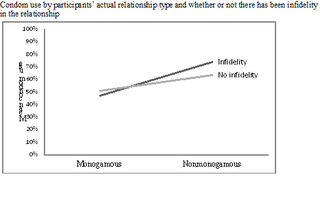Marriage
Could Monogamy Actually Increase the Risk of HIV Infection?
If love has anything to do with it, the answer may be yes!
Posted April 6, 2016
Welcome to my inaugural post! I am Dr. Joye Swan and my expertise is in intimate relationships, sexuality, and sexual behavior. Today’s post highlights the findings from my most recent research published this past January in the Journal of Sex Research. Enjoy and please send me your feedback, questions, and suggestions for future articles.
Humans are notoriously good at finding loopholes for their behavior. If I’m trying to lose weight and just ate a hot fudge sundae, I may rationalize this by saying, “I’ll skip dinner.” Or, if I’m trying to quit smoking I might excuse just one more cigarette because I’ve had a really stressful day and, we all know, that stress kills, right? Rationalizing our behavior is so common that psychology has a term for it, cognitive dissonance. It is the psychological discomfort created with our behavior doesn’t match our attitudes or beliefs. We look for ways to rationalize or bend reality to make these elements more consonant. Knowing this, it would really be no surprise to find that people also appear to be bending the “rules” when it comes to monogamy.
For many years now, monogamy has been touted as a key way to reduce an individual’s risk of contracting HIV and other STIs (sexually transmitted infections). And, over the past 20 years there has been a significant increase in people defining their relationships as monogamous. Since the message has been that monogamous sex is “safe sex,” condom use decreases significantly as soon as a relationship is defined as monogamous. The problem is that what many people define as monogamy is, at best, serial monogamy, the act of going from one short-term monogamous relationship to another, which, over time, results in multiple partners. But even serial monogamy may be too generous a label for many relationships. On average, research shows that about 30% of heterosexual college student and 50% of gay male self-identified “monogamous” relationships aren’t sexually monogamous at all. And yet, these people still believe their relationship provides a safe sexual environment and, therefore, still forego condom use despite their relationship not being sexually monogamous.
Our question, then, was how can individuals label a relationship monogamous, when it is clearly not, and then use the perceived safety of monogamy to forego condom use? Knowing that people rationalize their behavioral missteps, we looked at how people might bend reality to make sense out of the two factors “I’ve defined my relationship as monogamous when it is not” and “Because I’m in a “monogamous” relationship, I can forego condom use.” What we hypothesized is that people are using their emotional attachment, rather than their sexual fidelity, to define their relationship as monogamous. In short, I may have sex with Tom, Dick, and Harry, but I’m “monogamous” with Tom because he’s the only one I love.
Over 650 gay men and college students (two groups at increased risk of sexually transmitted infections) participated in the study. We asked them to determine if a hypothetical relationship was monogamous based on three infidelity scenarios. Although all participants received identical scenarios describing a primary relationship and an act of infidelity, only half of the participants received information in the scenario which cued them to their emotional attachment to their primary partner (we simply added words like “although you love your partner,” or “because you love your partner,” etc.). We found that in all three scenarios when love was mentioned, participants were more likely to say the relationship was still monogamous, despite the act of infidelity, than participants who didn’t receive the emotional cues. Further, when looking at our participants’ own relationships, we found that those who labeled their actual relationship monogamous, yet also reported sex outside their relationship, used condoms significantly less than those who reported sex outside their non-monogamous relationship.

These results carry significant weight. If someone labels their relationship monogamous, when it is not, and then uses the perceived safety of monogamy to forego condom use, then monogamy, as practiced in the real world, could increase an individual’s risk of HIV and STIs. And, in fact, many people who contract HIV do so in the context of a relationship rather from a stranger or a one-night-stand.
Sex in a single-lifelong-mutually-monogamous relationship-with an uninfected partner, may be a very safe situation. However, the probability of this happening for many people, is very small. People want to believe they are invulnerable to risk and that it “wouldn’t happen to me,” so, rather than changing their behavior, they bend the message to fit their reality. Our public health messages must catch up, and catch on, to, people’s relationship realities. Love is not a barrier to sexually transmitted diseases and, therefore, monogamy, as practiced in the real world, is a protective fallacy.


